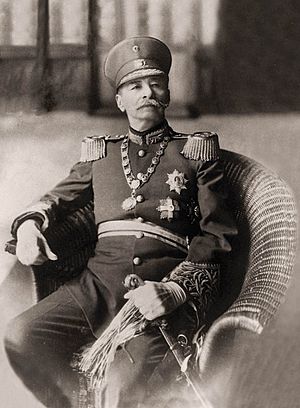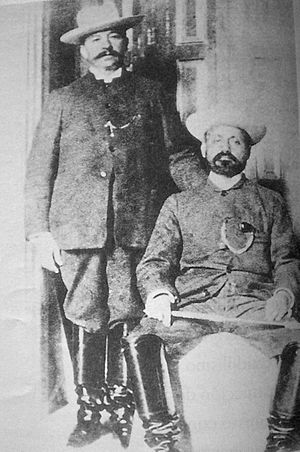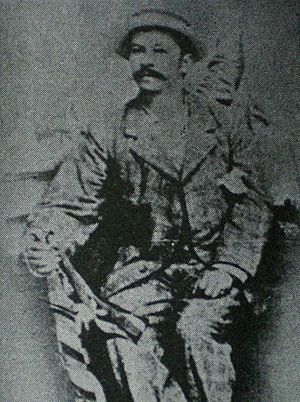Juan Vicente Gómez facts for kids
Quick facts for kids
Juan Vicente Gómez
|
|
|---|---|
 |
|
| President of Venezuela | |
| In office 19 December 1908 – 13 August 1913 |
|
| Preceded by | Cipriano Castro |
| Succeeded by | José Gil Fortoul |
| In office 24 June 1922 – 30 May 1929 |
|
| Preceded by | Victorino Márquez Bustillos |
| Succeeded by | Juan Bautista Pérez |
| In office 13 June 1931 – 17 December 1935 |
|
| Preceded by | Juan Bautista Pérez |
| Succeeded by | Eleazar López Contreras |
| Personal details | |
| Born | 24 July 1857 Hacienda La Mulera, Táchira, Venezuela |
| Died | 17 December 1935 (aged 78) Maracay, Aragua, Venezuela |
| Children |
List
José Vicente
Josefa Alí Flor de María Graciela Servilia Gonzalo Juan Vicente Florencio Rosa Amelia Hermenegilda Cristina Belén Berta Manuel Antonio Juan Crisóstomo Gómez |
| Signature | |
Juan Vicente Gómez Chacón (born July 24, 1857 – died December 17, 1935) was a Venezuelan military general and politician. He ruled Venezuela from 1908 until his death in 1935. He served as president three times during this period. In between, he often ruled through other leaders who followed his directions.
During his time in power, many important public works were completed. He started Venezuela's first airline, Aeropostal Alas de Venezuela. He also created the Venezuelan Military Aviation. He ordered the building of Venezuela's first airports. These included Maracaibo International Airport and the one in Maracay, which is now Florencio Gomez National Airport.
Other projects included bridges and customs buildings. The first intercity bus line, called the Venezuelan Airbus, was also created. The famous Trasandina highway was built too. This road goes from Las Adjuntas near Caracas to San Antonio del Táchira. He also helped organize the military into what it is today.
Even though some people saw him as a very strict ruler, his government tried to appear fair. He used short-term presidents like Victorino Márquez Bustillos and Juan Bautista Pérez. This allowed him to keep control of the country's administration.
Contents
Early Life and Rise to Power
Gómez was born into a well-known family of landowners in the La Mulera region. He was the first son of Pedro Cornelio Gomez and Hermenegilda Chacon Alarcon. In 1899, he joined the army of Cipriano Castro. They had been friends since Castro was living in Colombia.
Castro's army marched into Caracas in 1899 and took control of Venezuela. Gómez became Castro's vice president. By 1902, he was the head of the military. He was in charge of stopping several big rebellions against the government. On December 19, 1908, Gómez took power from Castro. This happened while Castro was in Europe for medical treatment.
Gómez as President

As president, Gómez greatly reduced Venezuela's large national debt. He did this by allowing foreign oil companies to operate in Venezuela. This happened after oil was found in Lake Maracaibo in 1918. This helped him gain support from the United States and Europe. It also brought economic stability to Venezuela.
He used some of the money to start many public building projects. He also became very wealthy himself. Because of his work for the country, the Congress gave him the title El Benemérito, meaning "the Meritorious One." However, his opponents called him El Bagre ("the Catfish") because of his mustache. They also called him "the Tyrant of the Andes" because he came from the mountain state of Táchira.
On April 19, 1914, Gómez appeared to step down from office. He let Victorino Márquez Bustillos become the temporary president. But Gómez continued to control the country from his home in Maracay. He officially returned to office in 1922 and ruled until April 22, 1929.
Even though he was re-elected by the Congress, he chose not to move back to the capital. Juan Bautista Pérez became president, but Gómez still made all the final decisions. On June 13, 1931, Congress made Pérez resign. They then elected Gómez as president again. This time, he took office and ruled until his death.
Opposition to His Rule
The Generation of 1928 was a group of students. They led protests in 1928 against Gómez in Caracas. Some famous members included Rómulo Betancourt, Jóvito Villalba, and Andrés Eloy Blanco. These young people wanted more freedom and democracy for Venezuela.
His Family Life
Gómez never officially married. However, he had two main partners. With Dionisia Gómez Bello, he had seven children. With Dolores Amelia Nunez Linares' de Cáceres, he had nine children. He also had many other children from other relationships. It is believed he had at least 64 children, possibly up to 99. He often gave his children important jobs in the government. This led to accusations of nepotism, meaning favoring family members.
Legacy of Juan Vicente Gómez

Gómez's time ruling Venezuela is a much-discussed period in the country's history. His leadership brought wealth to Venezuela, especially after oil was discovered. This wealth helped build modern roads and other important structures. His focus on road building and new jobs in the oil industry helped people travel more. This brought Venezuelans from different regions closer together. It helped create a stronger sense of national unity.
He also ended civil wars and political uprisings. He took power from local leaders, called caudillos, to strengthen his own control. As a result, Venezuela became a peaceful country for many decades. He paid off all of Venezuela's foreign and internal debts. His careful money management helped the country get through the Wall Street Crash of 1929 and the Great Depression. This even made the value of the bolívar currency stronger.
However, his rule also had downsides. Many people believe that most of the country's wealth ended up with Gómez and his close friends. He became the richest man in Venezuela by the time he died. The peace and wealth came at the cost of democracy. People had limited freedom, and his secret police watched everyone closely. He also did not focus much on public education. He was known for being tough on anyone who disagreed with him. Some accused him of treating the country almost like his own property.
Under Gómez, Venezuela gained more independence and financial progress. After oil was found near Lake Maracaibo in 1914, Gómez made smart deals with oil companies from the United States, the United Kingdom, and the Netherlands. These deals benefited Venezuela. He worked to keep good relationships with other countries and managed to pay off all foreign debt. He controlled local leaders and the Roman Catholic Church. He started many public works and created a well-organized government.
Former Venezuelan President Rómulo Betancourt wrote that Gómez was more than just a local ruler. He said Gómez helped foreign companies control Venezuela's economy. This was because companies like Royal Dutch Shell and Standard Oil made deals with him to get oil exploration rights.
In Venezuelan politics, Juan Vicente Gómez has come to represent strong, long-lasting political power. The Juan Vicente Gómez International Airport was named after him in 1993.
Distinctions and Decorations
- There is a statue of Juan Vicente Gómez in the Aeronautics Museum of Maracay.
- The Venezuelan airport of Juan Vicente Gómez International Airport is named after him. This happened in 1993.
National Decorations
- Order of the Liberator (1908-1913/1922-1929/1931-1935)
- Order of Francisco de Miranda (1908-1913/1922-1929/1931-1935)
International Decorations
- Order of Boyacá
- Order of Pope Pius IX
- Order of Leopold (Belgium)
- Order of Charles III
See also
 In Spanish: Juan Vicente Gómez para niños
In Spanish: Juan Vicente Gómez para niños
- Presidents of Venezuela
- List of Venezuelans


